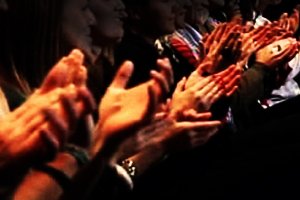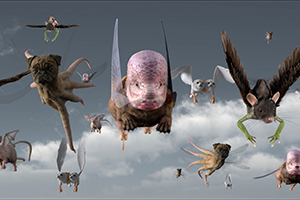ART from ELSEWHERE – Seoul Selection
Video Art from the MOMENTUM Collection, Berlin
Screening At The
21st Seoul International ALT
Cinema & Media Festival (NeMaf)
19 – 27 August 2021
Curated by Rachel Rits-Volloch & Emilio Rapanà
Co-Presented by:
Featuring:
AES+F // Theo Eshetu // Amir Fattal // David Krippendorff // Almagul Menlibayeva // Nina E. Schönefeld // David Szauder
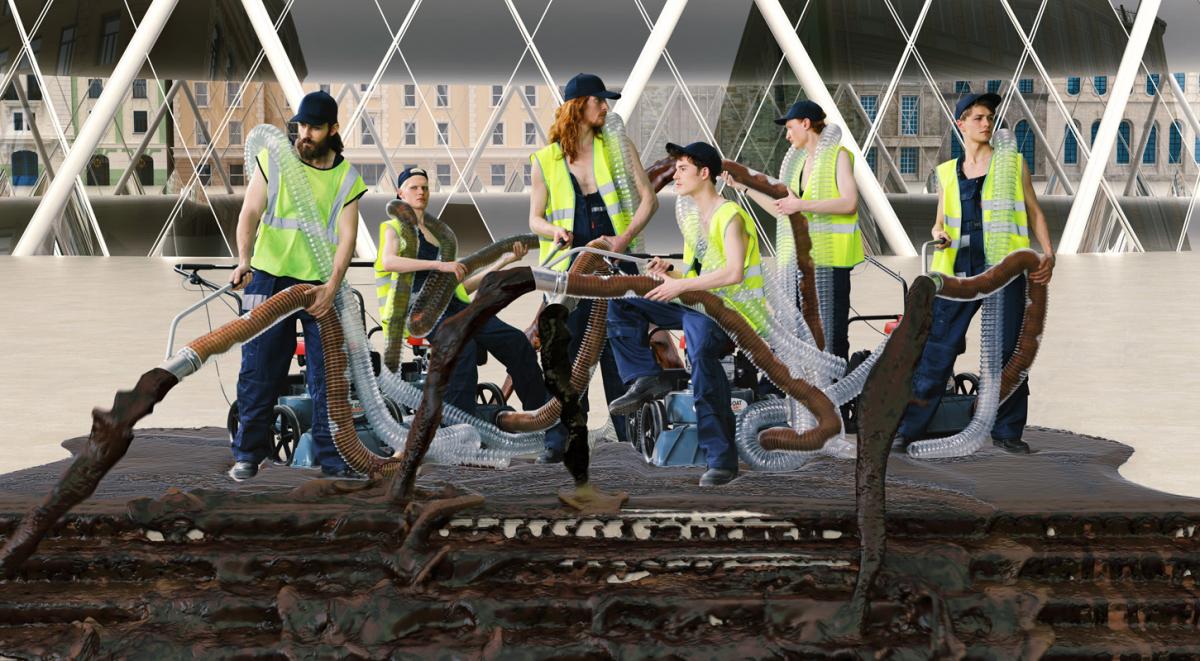
PROGRAM :
AES+F, Inverso Mundus (2015), 4K Video Art, 38 min.
Nina E. Schönefeld, B. T. R. (Born to Run) (2020), HD Video Art, 20 min. 3 sec.
Amir Fattal, ATARA (2019), HD Video Art, 15 min. 20 sec.
David Szauder, Light Space Materia (2020), HD Video Art & Digital Animation, 8 min. 27 sec.
Theo Eshetu, Festival of Sacrifice (2012), HD Video Art, 18 min.
Almagul Menlibayeva, Transoxania Dreams (2011), HD Video Art, 23 min., Kazakh with English Subtitles
David Krippendorff, Nothing Escapes My Eyes (2015), HD Video Art, 14 min. 9 sec.
Curatorial Statement
For the 21st Seoul International Alt Cinema and Media Festival, the streaming art film platform IkonoTV was invited to present a selection of German video art. In turn, IkonoTV invited MOMENTUM, the Global Platform for Time-Based Art, to curate a selection of works from its Collection by Berlin-based artists. The result is a program of seven exceptional artworks by artists as diverse as Berlin itself. Presenting artists from Ethiopia, Germany, Hungary, Israel, Kazakhstan, Russia, and the US – they are all Berliners. At the geographical center of Europe, Berlin is a city of mobile people and moving images, where art and artists alike are often from elsewhere. In this post-pandemic era of travel restrictions Art from Elsewhere – Seoul Selection is a video program about otherness – a way of seeing the world without travelling. Moving images move us, and artworks serve as windows onto the world. As we now emerge carefully after months of isolation, and learn how to negotiate the new realities of a post-pandemic world, it becomes more important than ever to have such windows through which to gaze. In these uncertain times, they remind us that, for all our differences, we are all in this together. The works shown in this program focus on global issues, equally relevant to us all. They reflect on the social and environmental repercussions of globalization and its impact on the transformation of cultural identities; they interrogate issues of gender, inequality, and poverty; they scrutinize the environmental traumas we inflict on our planet and its creatures; and they ponder the (un)quiet poetry, conflicts, and beauty of how we must live from day to day.
– Rachel Rits-volloch
AES+F
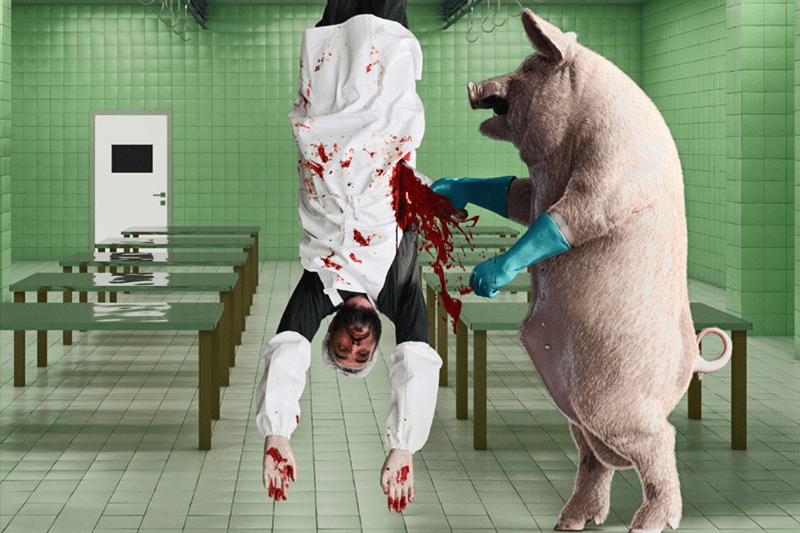
Inverso Mundus(2015), 4K Video Art, 38 min.
The title of this video, Inverso Mundus, means the world upside down. Engravings in the genre of “World Upside Down”, known since the 16th century, depict such scenes as a pig gutting the butcher, a child punishing his teacher, a man carrying a donkey on his back, man and woman exchanging roles and dress, and a beggar in rags magnanimously bestowing alms on a rich man. These engravings contain demons, chimeras, fish flying through the sky and death itself, variously with a scythe or in the mask of a plague doctor. The title of the work, Inverso – both an Italian “reverse, the opposite” and the Old Italian “poetry,” and Mundus – the Latin “world,” hints at a reinterpretation of reality, a poetic vision. In our interpretation, the absurdist scenes from the medieval carnival appear as episodes of contemporary life in a multichannel video installation. Characters act out scenes of absurd social utopias and exchange masks, morphing from beggars to rich men, from policemen to thieves. Metrosexual street-cleaners are showering the city with refuse. Female inquisitors torture men on IKEA-style structures. Children and seniors are fighting in a kickboxing match. Inverso Mundus is a world where chimeras are pets and the Apocalypse is entertainment.
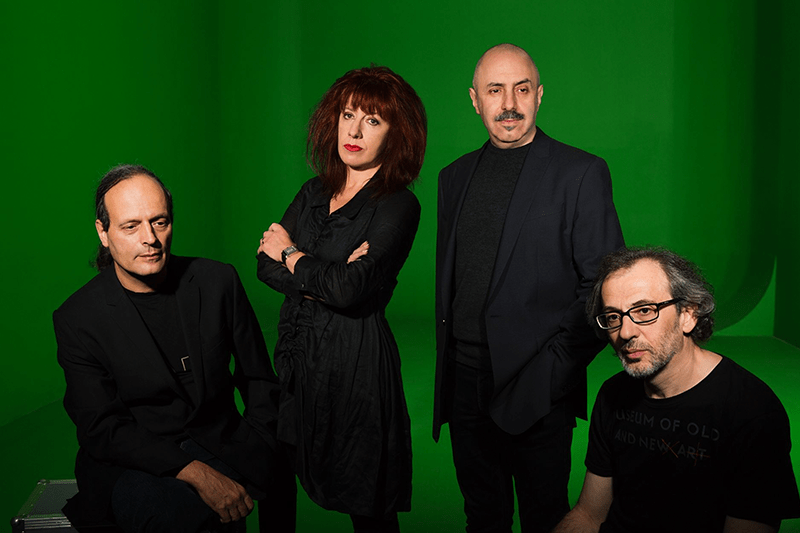
AES+F (Artist Group founded in 1987. Live and work in Berlin, Germany; Moscow, Russia; New York, USA.)
First formed as AES Group in 1987 by Tatiana Arzamasova, Lev Evzovich, and Evgeny Svyatsky, the collective became AES+F when Vladimir Fridkes joined in 1995. AES+F work at the intersection of traditional media, photography, video and digital technologies. They define their practice as a kind of “social psychoanalysis” through which they reveal and explore the values, vices and conflicts of contemporary global culture. In 2015, AES+F premiered Inverso Mundus at the 56th Biennale di Venezia, and later showed it at the Kochi-Muziris Biennial and a number of other museums and festivals around the world. AES+F achieved worldwide acclaim in the Russian Pavilion at the 52nd Biennale di Venezia in 2007, and since then have participated in many signature biennials around the world, including: Adelaide, Gwangju, Havana, Helsinki, Istanbul, Kiev, Kochi-Muziris, Lille, Lyon, Melbourne, Moscow, St. Moritz, Sydney, Taipei, Vancouver, and others. Festivals devoted to new media include: ARS Electronica (Linz), Mediacity Seoul and Video Zone (Tel Aviv). AES+F had over 100 solo exhibitions at museums and galleries worldwide, including: ZKM (Karlsruhe), HAM (Helsinki), Moderna Museet (Stockholm), Tate Britain (London), MAXXI and MACRO Future (Rome), Centre Pompidou (Paris), Museo Thyssen-Bornemisza (Madrid), Today Art Museum (Beijing), Mori Art Museum (Tokyo), Leeum Samsung Museum of Art (Seoul), State Russian Museum (St. Petersburg), Garage Museum of Contemporary Art (Moscow), National Gallery of Australia (Canberra), Faena Art Center (Buenos Aires), and many others.
Theo Eshetu
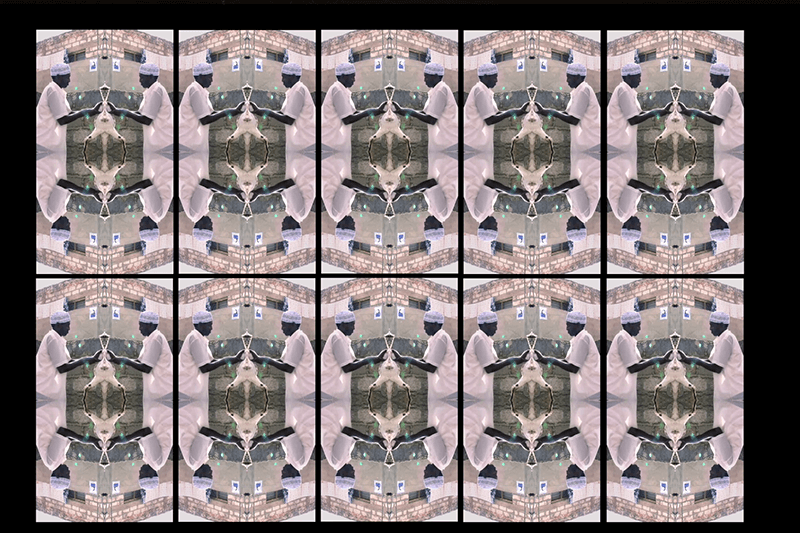
Festival of Sacrifice (2012), HD Video Art, 18 min.
Festival of Sacrifice was originally made as a 6-channel video installation, depicting the ritual slaughter of a goat during the celebration of Eid-ul-Adha, the Islamic Festival of Sacrifice. Through multiple mirroring the extreme footage is sublimated into a series of images that resemble traditional Islamic ornamentation. The skilled dissection of the animal body is reflected in the kaleidoscopic dissolution of the video image. The emotional and aesthetic aspects of ritual religious practices are here heightened by the musical soundtrack of the work. The celebration of Sacrifice harks back to the very origins of religious thought. All religions begin with a sacrifice. Festival of Sacrifice is part of a series of videos that looks at aspects of Islamic culture as a source to explore formal qualities of representation and the underlying links between cultures. Filmed on the Kenyan island of Lamu during the celebrations of Eid-ul-Adha, the video recreates, through the multiplication of images, the kaleidoscopic patterns that highlight the spiritual aspect of the event. Intercultural relations, whether seen as an exchange or a battle, are strongly influenced by the impact of images and their use. While religion and technological development are often used to reinforce differences, electronic inter-connectivity has created a platform for mutual interaction and transformed the very concept of landscape.
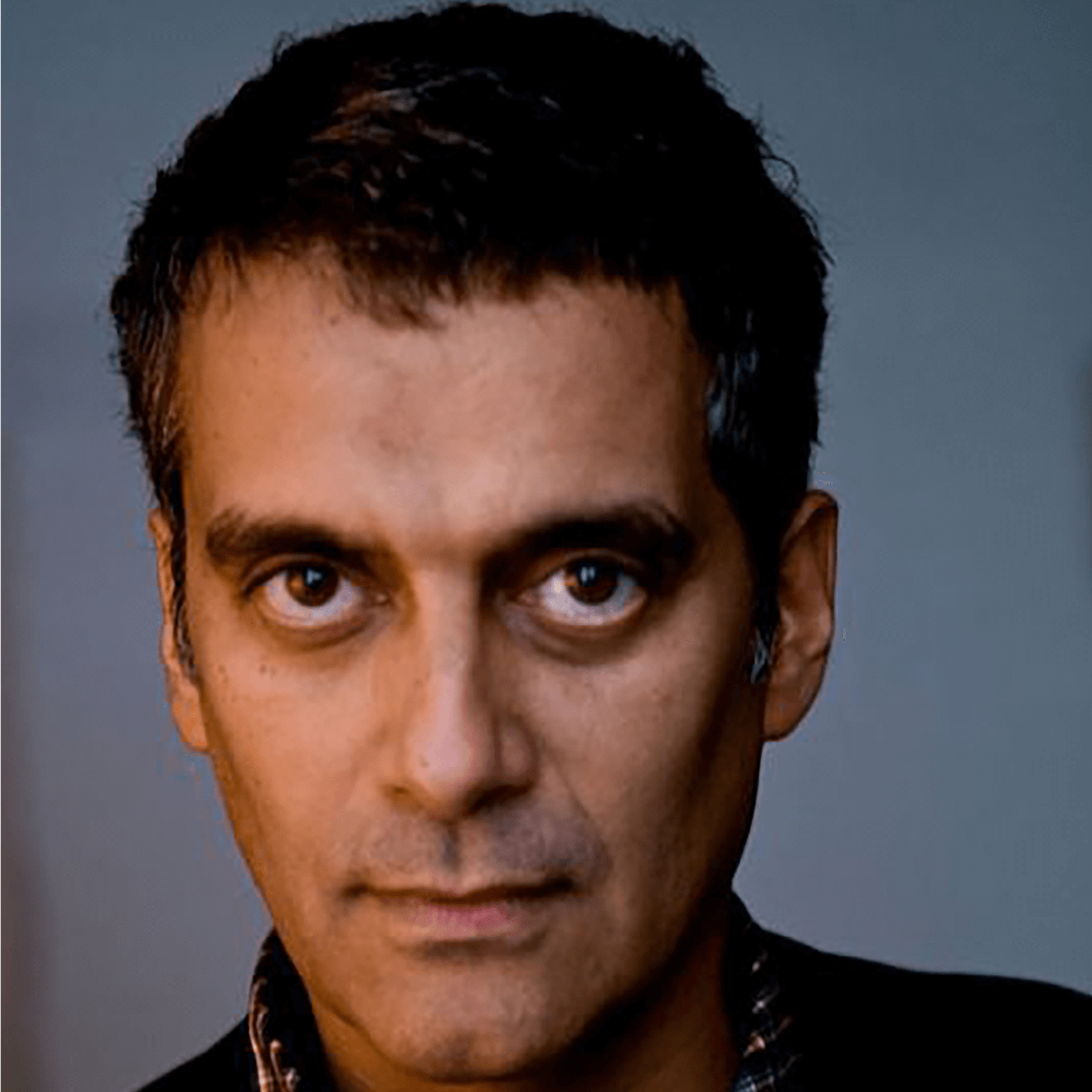
Theo Eshetu (b. 1958 in London, England. Lives and works in Berlin, Germany)
Ethiopian artist Theo Eshetu was born in London and grew up in Addis Ababa, Dakar, Belgrade and Rome. A pioneer of video art, Eshetu explores the relationship between media, identity, and global information networks. After studying Communication Design, Eshetu began making videos in early 1982, seeking to deconstruct the hegemonic status of television, which he viewed as a state apparatus. Forging a hybrid language to merge practices of video art and documentary filmmaking, Eshetu explores perception, identity, and notions of the sacred through electronic time-based media and optical devices and effects. He draws from anthropology, art history, scientific research, and religion—Catholic, African, Muslim, Buddhist—to explore clashes and harmonies of human subjectivity between world cultures in the global context. Though essentially conceptual, and often exploring video’s formal components of time and light, Eshetu’s work is often focused on cultural displacement, and is always grounded in compelling aesthetic components, often achieved through fractal repetition, such as kaleidoscopic mirroring, multi-screen projections, or mosaic-like patterning of images. Among various international awards, Eshetu was Artist in Residence at Tarabya Cultural Academy, Turkey where he completed aspects of production for Altas Fractured (2017) which was featured in Documenta 14, Athens and Kassel in 2017. In 2012 he was Artist in Residence at the DAAD program in Berlin, where he exhibited The Return of the Axum Obelisk at DAADgalerie in 2014. In 2011 he participated the Venice Biennale and the Sharjah Biennale. Eshetu’s work has been shown in many museums, biennials, and film festivals worldwide.
David Krippendorff
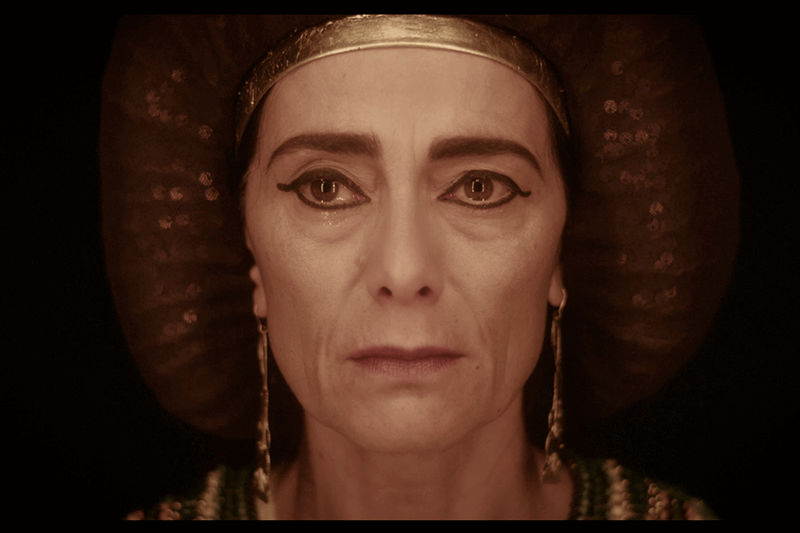
Nothing Escapes My Eyes (2015), HD Video Art, 14 min. 9 sec.
Nothing Escapes My Eyes takes us on an intimate journey through identity and history. David Krippendorff’s time-warping tribute to a changing world presents a would-be Aida, to a moving soundtrack from the eponymous opera, shedding tears for a place and time which no longer exist. Nothing Escapes My Eyes is about a silent transformation of a place and a human being, both subjected to the melancholy of conforming. The film was inspired by the famous opera Aida, to depict in a metaphoric form current issues of cultural identity, loss and the pressures to conform. The film refers to the following historical event related to this opera: Aida premiered in Cairo in 1871 at the Khedivial Opera House. One hundred years later the building was completely destroyed by fire and replaced by a multi-story parking garage. Nevertheless, to this day, the place is still named Opera Square: Meidan El Opera. The film combines this urban alteration with the painful transformation of a woman (actress Hiam Abbass) in the process of shedding one identity for another. With no dialogue, the film is backed by a musical excerpt from Verdi’s opera Aida, whose lyrics express the difficulties of being loyal to one’s country and cultural identity. The personal and urban transformation tackles issues of identity, loss and disorientation as a result of historical colonialism and contemporary globalization.
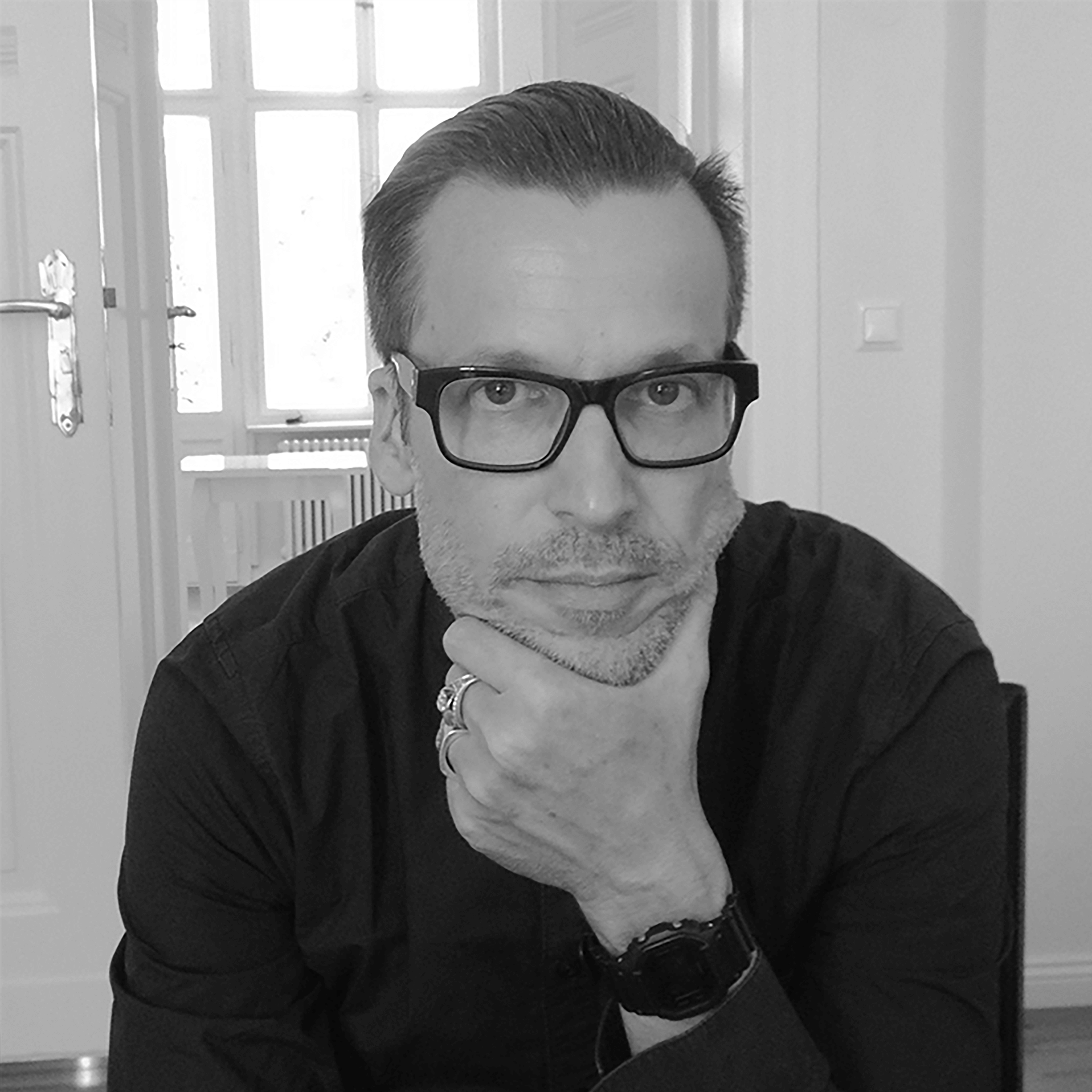
David Krippendoff (b. 1967 in Berlin, Germany. Lives and works in Berlin)
David Krippendorff is a US/German interdisciplinary artist and experimental filmmaker. He grew up in Rome, Italy, and studied art at the University of Fine Arts in Berlin, where he graduated with a Masters degree in 1997, and was subsequently based in New York for some time. The son of a Holocaust survivor and the grandchild of practicing Nazis, cultural contradiction and dislocation shaped Krippendorff’s experience early on. His artistic practice inquires into this state of being a “permanent foreigner” and explores resulting questions of home, national and cultural identity, and belonging. Krippendorff’s works, films and videos have been shown internationally, including at: the New Museum (New York), ICA (London), Hamburger Kunsthalle (Hamburg), Museum on the Seam (Jerusalem). He has participated in four Biennials (Prague, Poznan, Tel Aviv, and Belgrade), as well as in many international art and film festivals worldwide.
Amir Fattal
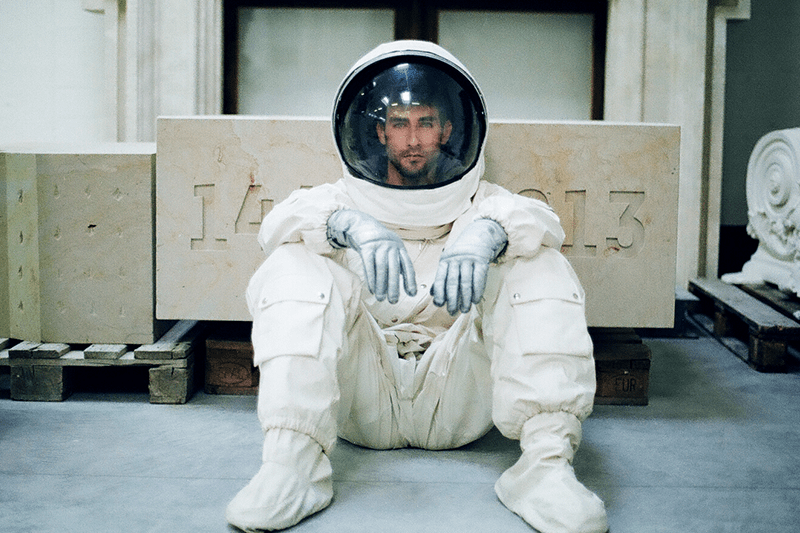
ATARA (2019), HD Video Art, 15 min. 20 sec.
Shot on location in Berlin, ATARA tells the story of two iconic buildings that used to stand at the same place: the Berliner Stadtschloss, destroyed by Allied bombing in WWII, and the Palast der Republik, built in its place as the GDR seat of government in 1973, and destroyed in 2008 to make way for the rebuilding of a contemporary copy of the Stadtschloss. The resurrection of this historical copy did not begin until 2013 due to the controversy surrounding this project. In a city perpetually treading the fine line between moving on from its painful history while never forgetting it, the decision to resurrect the Stadtschloss is interpreted by many as a willful erasure of its GDR past and a dangerous rewriting of history. This controversy is keenly felt in a city still building over its bomb craters, even more than 75 years after the end of WWII. ATARA follows a symbolic ceremony that takes place in the Palace during a moment when one building is being resurrected and the other building is dematerializing into a ghostly memory. Following an astronaut wandering through the construction site of the new Stadtschloss, carrying an iconic lamp from the destroyed Palast der Republik, ATARA deals with the collective memory of architecture and its symbolic representation in public space. The music is based on the Liebestod aria from Wagner’s opera ‘Tristan and Isolde’, rewriting the musical score as mirror of the original then digitally reversing it, like travelling backwards and forwards in time.
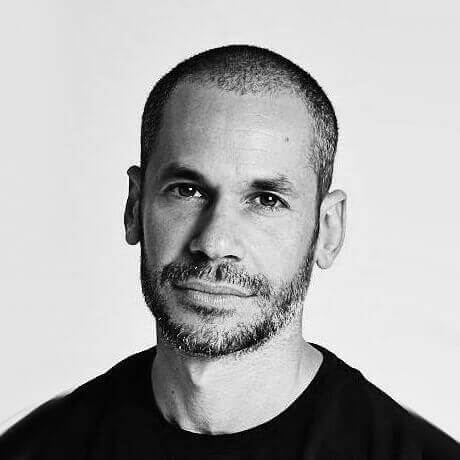
Amir Fattal (b. 1978 in Tel Aviv, Israel. Lives and works in Berlin, Germany)
Fattal is a conceptual artist whose practice is one of historical reflection grounded in the history of aesthetics and cultural schisms. Working in the media of video, photography, sculpture, and installation, his work forms a focused response to the diverse questions raised by his adoptive city of Berlin, where the memory, culture, architecture, indeed every thread in the fabric of this city is problematized by its history. Alongside his art practice, Fattal is the curator of Tape Modern Berlin, an acclaimed series of group exhibitions featuring emerging and established artists. Amir Fattal was distinguished with the GASAG Art Prize in 2008 and graduated from Universität der Künste, Berlin, in 2009. Acclaimed group exhibitions include: Collection Enea Righi, Museo Fortuny, Venice (2016); Interior / Exterior / Sculpture, Belenius/Nordenhake Gallery, Stockholm, Sweden (2015); A Naked Singularity, Studio Garaicoa, Madrid, Spain (2015); Fragments of Empires, MOMENTUM, Berlin (2014-15); A Letter From Dr. Faustus, Herzliya Museum of Contemporary Art, Israel (2014); Fundación Botín, Villa Iris, Santander, Spain (2014); Dahlstrøm & Fattal, Beers Lambert Contemporary, London (2013); III Moscow International Biennale for Young Art, Moscow, Russia (2012); Body Without Body, Georg Kolbe Museum, Berlin (2011).
Almagul Menlibayeva
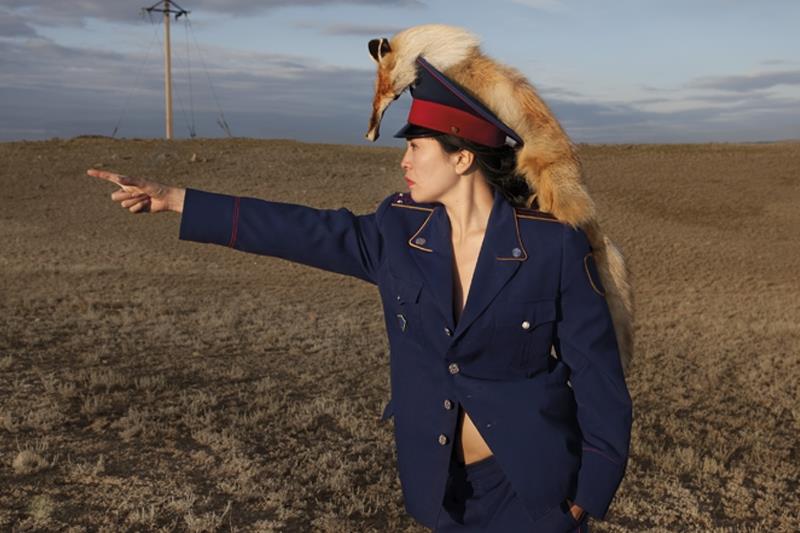
Transoxania Dreams (2011), HD Video Art, 23 min., Kazakh with English Subtitles
Almagul Menlibayeva’s film tells a tale of ecological devastation in the guise of a mythological narrative staged in the vast landscape of her native Kazakhstan, ravaged by 60 years of Soviet occupation. Transoxania Dreams is filmed in the brutally changed region of the Aral Sea, where its indigenous people live in the Aralkum, the desert of a once-thriving region now entirely devoid of water due to radical Soviet irrigation policies. The region of Transoxania in southwestern Kazakhstan, Uzbekistan and Tajikistan, once the eastern part of the Hellenistic regime under Alexander the Great, remained an important trade region along the Northern Silk Road with flourishing civilizations and fertile plains for many centuries. Afflicted by former Soviet policies and abandoned by commercial and cultural interests, today, Transoxania lies bare and stripped in a surreal state of existence with discarded fishing fleets on dusty terrain ravaged by metal scavengers, while its inhabitants look on as the sea keeps receding into a far and unreachable distance. Menlibayeva tells the tale of a young fisherman’s daughter observing the dramatic changes to the landscape of the Aral region and its population through a child’s eyes in a dreamlike mélange of documentary and fantasy. In her symbolic dream, the girl’s father searches for the remaining sea and new fishing grounds while encountering strange and seductive four-legged female creatures on his way through the hostile desert. Drawing on the mythological figures of the Centaur and of Kazakh folklore, Menlibayeva creates a magical landscape with alluring hybrid beings, sexually charged and bizarre.

Almagul Menlibayeva (b. 1969 in Almaty, Kazakh SSR. Lives and works in Berlin, Germany and Almaty, Kazakhstan.)
Almagul Menlibayeva is a video artist, photographer, and curator, holding an MFA from the Art and Theatre University of Almaty. Working primarily in multi-channel video, photography and mixed media installation, Menlibayeva’s practice addresses such critical issues of post-Soviet modernity as: the social, economic, and political transformations in Central Asia; de-colonial re-imaginings of gender; environmental degradation; and Eurasian nomadic and indigenous cosmologies and mythologies. In conjunction with her solo exhibition ‘Transformation’ at the Grand Palais in Paris (France, 2016-17), she was awarded the prestigious Chevalier Ordre des Arts et des Lettres by the French Minister of Culture in 2017. Among other notable awards, she was the Winner of the Main Prize of the International Film Festival Kino Der Kunst (2013) in Munich, Germany, and shortlisted for the Sovereign Asian Art Prize, Hong Kong (2020). Menlibayeva participated in numerous international biennales, including: the Asia Pacific Triennale, Brisbane, Australia (2020, 2012); Lahore Biennale, Pakistan (2020); Channels Festival, Biennial of Video Art, Melbourne, Australia (2019); Cairo Biennial, Egypt (2019); Gangwon International Biennale, South Korea (2018); Daegu Photo Biennale (2016); Venice Biennale, Italy (2005, 2007, 2009, 2015); Moscow Biennale, Russia (2011, 2015); Kiev Biennial, Ukraine (2013); Sydney Biennale, Australia (2006, 2012); Sharjah Biennial, UAE (2010); Mediterranean Biennale, Israel (2010); and many others.
Nina E. Schönefeld

B.T.R. (Born to Run) (2020), HD Video Art, 20 min. 3 sec.
Video and installation artist Nina E. Schönefeld examines the contemporary social and political climate, exploring the relationship between art, blockbuster movies and the present digital age. Her stories imagine a world where, due to drastic political shift, we need to fight for our democratic rights and survival. B.T.R. is set in the year 2043 in a dystopian future of authoritarian autocracies and restrictions on journalism, where data is the most valuable asset on earth, and authoritarian right-wing governments have implemented youth education camps to gain power and influence. The film’s hero, SKY, grew up in one such education camp, WHITE ROCK. Knowing nothing about her parents she begins to research her heritage, getting in touch with a group of independent journalists and publishers, the most persecuted people on earth, threatened by prison and death every day. In this allegory of a not far-distant future, it seems that freedom of speech is lost forever. The video B.T.R. is intended as a preventative measure against such dystopias. It was created as a film of the future but has its roots in the present. It is based on detailed research on Julian Assange and Edward Snowden; on Cambridge Analytica and the pervasive power of data mining; on the crucial role of investigative journalism and the need for freedoms of the press; on the stories of deserters from the far-right.; and on the growing strength of far-right movements around the world, which leads Schönefeld to draw frightening parallels with conditions which led to the rise of Fascism in Germany in the 1920s.

Nina E. Schönefeld (b. 1972 in Berlin, Germany. Lives and works in Berlin)
Nina E. Schönefeld is a multidisciplinary artist who studied Fine Art in Berlin at the Universität der Künste, and in London at the Royal College of Art. She holds a Master of Arts and a PhD in Art Theory. For several years she has been lecturing at private art colleges in the field of visual arts. She is the co-founder of “Last Night In Berlin”, a blog and cultural project documenting art openings in Berlin. Schönefeld’s work has been featured in numerous exhibitions around the world. Recent exhibitions include: “Roppongi Art Night”, Tokyo, Japan (2021); “Am Limit”, Cole mine Důl Michal, Ostrava, Czech Republic (2021); “Facing New Challenges: Water”, Heidelberger Kunstverein, Heidelberg, Germany (2020); “#Payetonconfinement”, Galerie la Pierre Large, Strasbourg, France (2020); “Topographies of The Stack”, Alternative Culture Making Art Space, Shenzhen, China (2019); “Water(Proof)”, Federation Square, Melbourne, Australia (2019) & MOMENTUM, Berlin, Germany (2019); “Anima Mundi Festival 2019 – Consciousness”, Palazzo Ca’ Zanardi, Venice, Italy (2019); “30 Jahre. 30 Fragen. 30 Stunden.”, Goethe Institut – Beijing, China (2018); “Join the Dots / Unire le distanze Salone Degli Incanti”, Ex Pescheria Centrale, Trieste, Italy (2018); “Light Year 25”, Manhattan Bridge / Kuelbs Collection, NY, USA (2017); and many others.
David Szauder
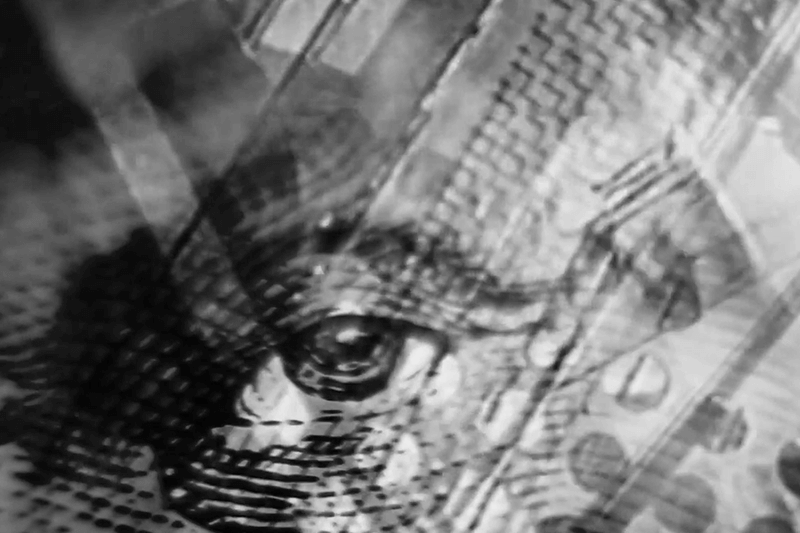
Light Space Materia (2020), HD Video Art & Digital Animation, 8 min. 27 sec.
David Szauder’s film Light Space Materia translates Bauhaus ideas on technology, new materials, and light into a digital context, upgrading an iconic work of the 1930s into a 3D digital animation and algorithmically derived soundscape. Taking as his inspiration the kinetic light and sound sculpture Light Space Modulator (1930) by one of the founding fathers of the Bauhaus, Moholy-Nagy, David Szauder re-created his own large-scale rendition of this iconic work in 2020. Szauder subsequently used this installation as the basis upon which to make a series of over 100 videos, digital animations, and soundscapes. Szauder recontextualizes into digital media the driving principal of the Bauhaus, Moholy-Nagy’s aim to revolutionize human perception and thereby enable society to better apprehend the modern technological world. Szauder’s analysis of the Bauhaus-related kinetics of the original piece focuses on the fundamental question of how contemporary technology could change the formal expression of movement and capture the physicality of materials in a digital context. The Bauhaus always held an important pioneering position in the relationship of art to technology. This characteristic forms the essential basis of Szauder’s work, which applies computer code to create his animations and soundscapes derived from the ambient sound and kinetic movement of his Light Space Modulator sculpture using algorithms based on motion analysis. This soundscape accompanies Szauder’s film Light Space Materia, which commingles found footage related to the seminal ideas of the Bauhaus with digital 3D animations made by the artist to foreground the haptic qualities of materiality of the image.
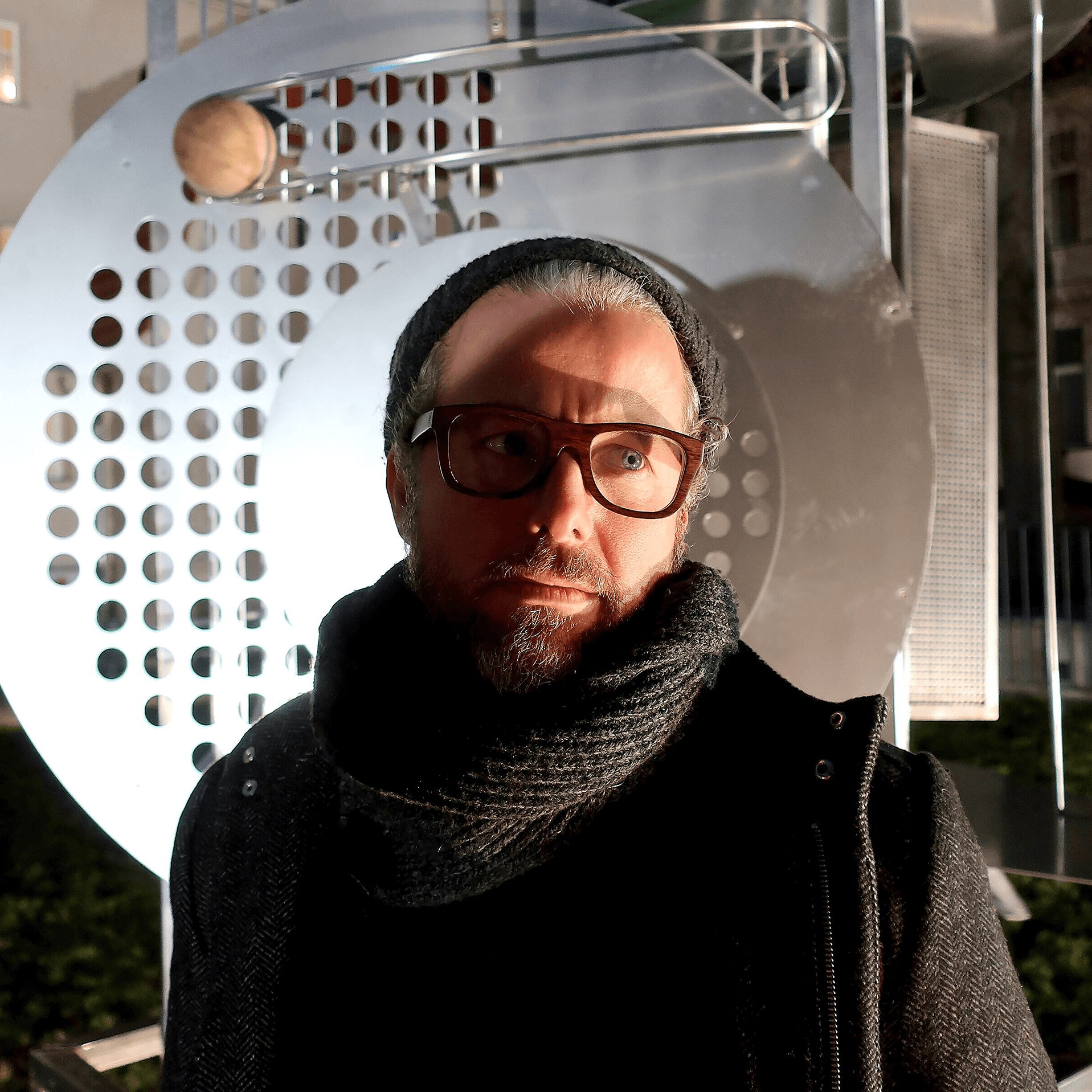
David Szauder (b. 1976 in Hungary. Lives and works in Berlin, Germany)
Media artist and curator David Szauder studied Art History at the Eötvös Loránd University and Intermedia at the Hungarian University of Fine Arts in Budapest, and completed a Masters Fellowship at the School of Arts, Design and Architecture at the Aalto University in Helsinki. From 2009 to 2014 he worked as the curator at the Hungarian Cultural Institute (CHB) in Berlin. David Szauder is a visiting lecturer at the Film Academy, Potsdam, in addition to leading workshops on interactive media in Berlin and Budapest since 2010. He is the Founder and Artistic Director of Buildingscape, an initiative to turn construction sites into venues for public art. Since 2019, he is the New Media Advisor for the Artistic Director of the VEB 2023 European Capital of Culture. David Szauder has participated in numerous international projects as artist and curator.


 Back to Homepage
Back to Homepage